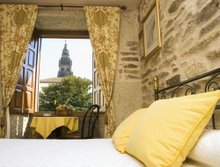Tuesday, June 12
On being under-guidebooked
Having been an editor and writer of guidebooks, I know how out of date, incomplete, random, and annoying they can be. They create blinders, advising you that this church but not another is worth a look, or telling you why you should be moved by a certain sight. Just as sometimes when I visit a museum I ignore the information cards and focus only on the art, I deliberately brought along on this trip very little in the way of guidance. No map, and just a few pages torn out of the British Confraternity of St. James guide, which, it turned out, was two years old.
That approach has been fine (and I´ve picked up many information sheets along the way, the most useful being a graph which shows the elevation gained and lost for each stretch of trail). When it backfires is when your scant information causes you to stop at Gonzar at noon when if you´d kept going there would have been many lovely options, not far away.
Oh well. Gonzar was a small price to pay for not being told, at every turn, what to see, how to feel, and where to stay.
But San Xulian was great. The small private Albergue o Abrigadoira was beautiful and well-run. There were cloth towels and although we only had bunks each had a pillow with a clean cotton pillowcase. Bed, breakfast,and the communal dinner cost 21 euros. Twelve or 14 Spaniards. 2 Germans, 2 Americans. Dinner conversation in rapid-fire Spanish. I´m back in the groove.
By the way, the people here really do speak their language, Gallego. it´s much more of a living tongue than is, say, Gaelic in Ireland. Galicia is said to be the cuña de Portugues (the cradle of the Portuguese language).
Good guides, modern and ancient
Many English speakers I run into swear by John Brierly´s A Pilgrim´s Guide to the Camino de Santiago: A Practical and Mystical Manual for the Modern Day Pilgrim. It has good route maps, small photos, charts that show gains and losses in elevation, and¨"mystical" as well as pratical advice. Examples of the former:
When you meet anyone, remember it is a holy encounter. And as you see them you will see yourself.
Or, for the hard climb up to O´Cebreiro;
Higher places help lift us toward Higher Mind. At such heights, a wider perpective opens up to both the physical and inner eye. What do you see, feel, and hear from this elevated space? Does the silence and peace in your heart allow your inner voice to be heard?
It´s a little bigger than a map (and a lot thicker and heavier). It outrages my sense of economy and indpedence by having blank lined pages titled Reflections, but all in all, it looks like a good guide. Maybe I´ll carry it next time around.
But if you want to go back to the orginal camino guide, get a copy of the illuminated manucript titled the Codex Calixtinus, written in the 12th century by a French monk and much used by the pilgrims of that peak time. The pilgrimage was at its height from the 9th to the 13th century, fell off for a few centuries, then picked up again in the 18th and 19th century for Spainiards and the 20th century for the rest of the world. It may be at one of its peaks right now. A Spaniard who has walked most of the Caminos in Spain told me that 400 - 500 pilgrims pour into Santiago every day.





1 comment:
I think it was the Spanish poet Jorge Guillén who wrote:
"Never steal ashtrays from a well-run albergue"
Post a Comment